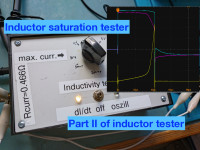Inductor Tester - Part 2 | Saturation Assesment

Inductors may loose their inductance at higher currents because of core material saturation, which limits the range of use. This is a second part of the description of a versatile simple inductor tester to be used in combination with a digital oscilloscope (https://www.elektormagazine.com/labs/simple-tool-to-assess-inductors-and-transformers-with-100nh-l-100h). This part pertains the quick assessment of non-linearities and saturation effects of small inductors. Giving hints on the maximum usage currents.
Here a tiny circuit is presented that in combination with an oscilloscope allows a quick assessment of the saturation approach. The circuit suddenly applies a voltage to the inductor under test and “measures” the current via a (small) voltage across a shunt resistor. Due to the inductance the current starts a zero and increases more or less linearly with time. As soon as this current i.e the shunt voltage voltage exceeds a preset limit the applied voltage will be cut off. After a waiting time of some 100 ms the cycle is repeated.
Monitoring the current rise in the inductor with the oscilloscope allows easy assessment of the non-linearities and saturation effects. Examples are shown below. Further quantitative analysis (also shown below) may yield inductance values as function of current. However, combined with the pulse excitation ringing frequency test to get the inductance value and the current-increase test described here combined in a tester (shown in figure 1) allows to get a comprehensive quick impression on the kind of inductor.
All relevant information (schematics, explanation, test) are compiled in the attached file InductanceTester_II.pdf.



Discussion (4 commentaire(s))